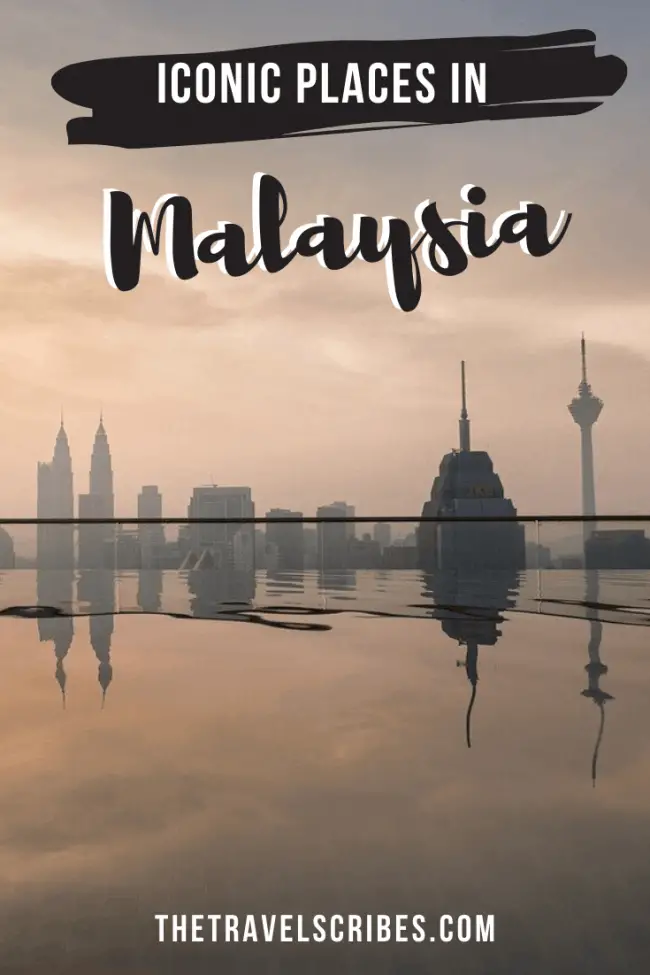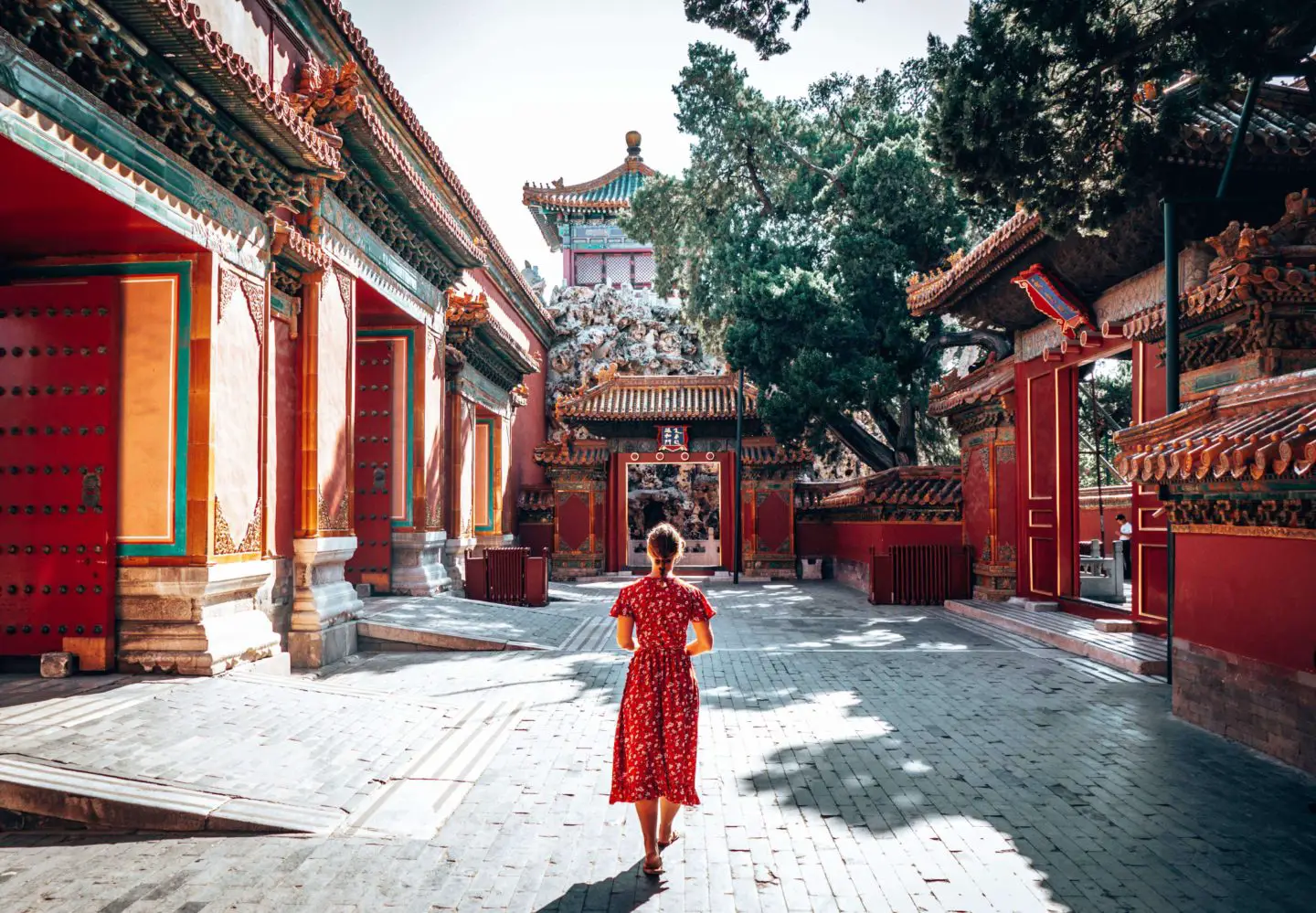The glimmering Petronas Tower soaring high above the Kuala Lumpur skyline. A mosque floating almost magically above the water in Melaka. Malaysia, that Southeast Asian country renowned for its incredible cuisine and some of the globe’s friendliest people, is also well-known for some of its iconic buildings. From street art epicentre Penang to Langkawi, bustling Kuala Lumpur to small town Ipoh and places like Borneo, the Cameron Highlands and everywhere in between, we asked some of the world’s leading travel bloggers to help us count down the most prominent places and iconic landmarks in Malaysia.
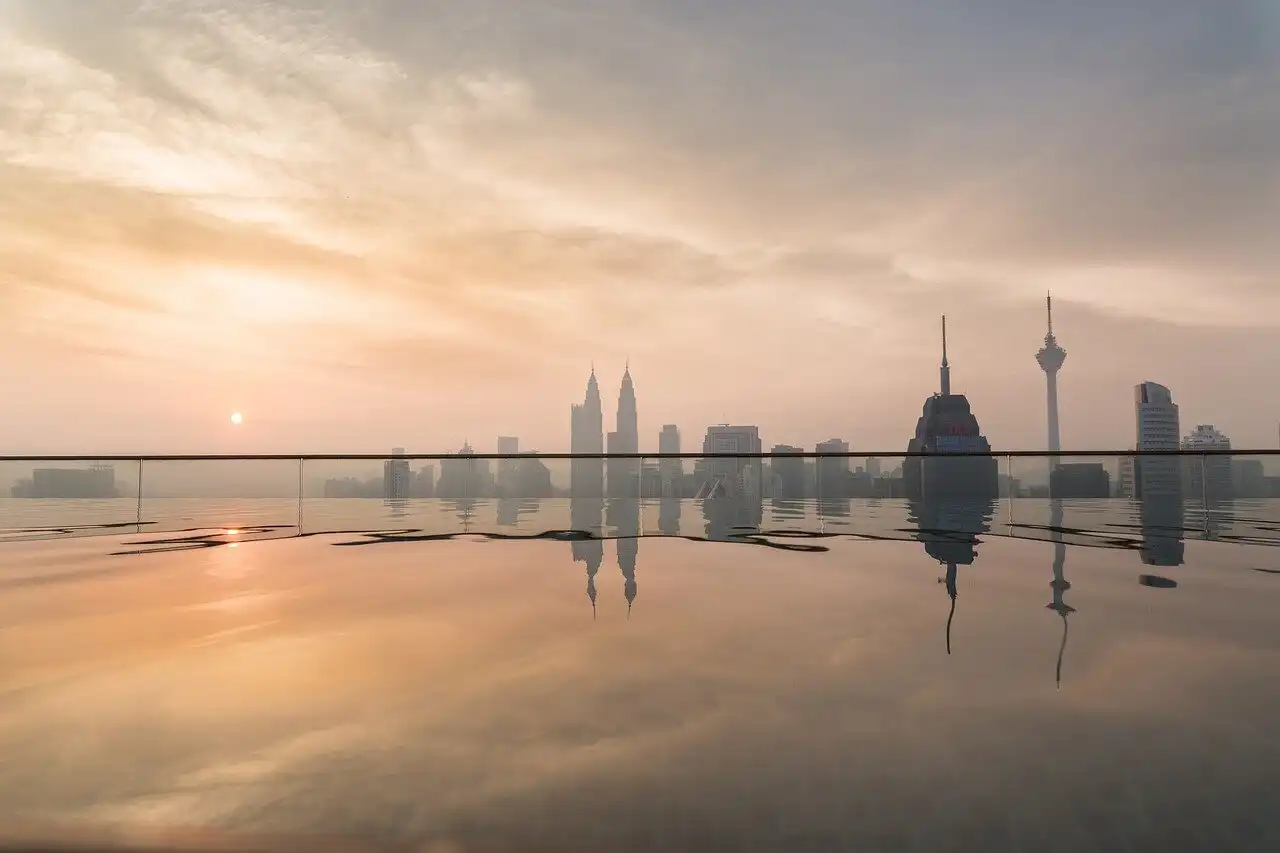
Skip ahead
Our Top 10 Landmarks in Malaysia
- Petronas Twin Towers, Kuala Lumpur
- Street Art in George Town, Penang
- Christ Church, Melaka
- Thean Hou Temple, Kuala Lumpur
- Batu Caves, Kuala Lumpur
- The Sky Bridge, Langkawi
- State Assembly Building & Darul Hana Bridge,
- The Floating Mosque, Melaka
- Sultan Abdul Samad Building, Kuala Lumpur
- Kek Lok Si Temple, Penang
Petronas Twin Towers, Kuala Lumpur
Explored by James from The Travel Scribes
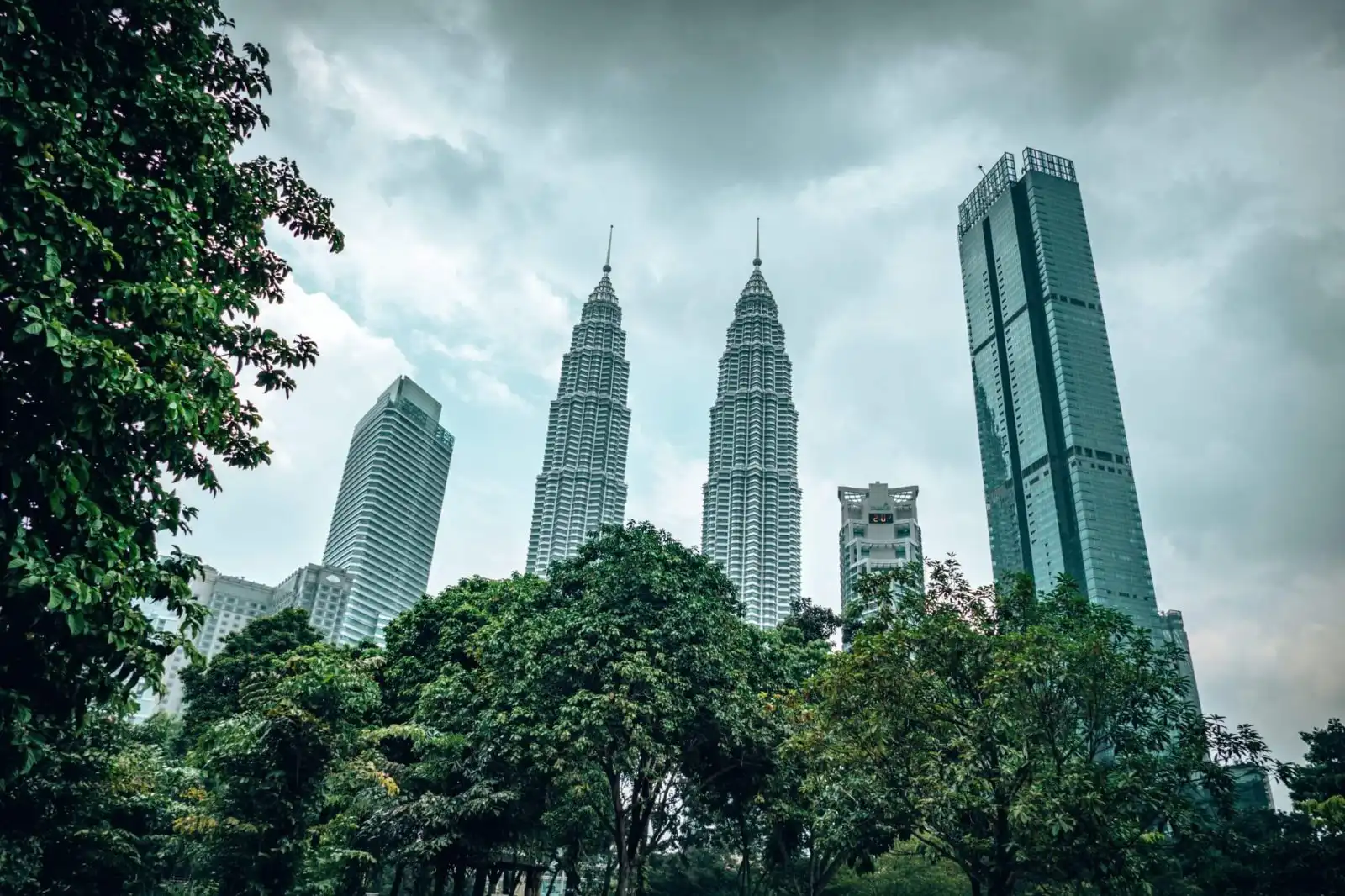
No list of landmarks in Malaysia would be complete without its crowning jewel: The Petronas Towers. They stand tall as the tallest twin towers in the world, reaching over 450 metres high, and between 1998 and 2004 even topped the list as the tallest buildings in the world outright.
The towers represent more than just a tall building to Malaysians – they were envisioned to symbolize the country’s ambition to be a global powerhouse, with the use of glittering glass and steel styled to mimic Islamic art motifs, a nod to the dominant religion in Malaysia. Completed in 1996, the building work faced a number of challenges in the 3 years it took: decayed limestone foundations which meant the entire building site had to be moved, issues with the concrete failing strength tests and an increased cost for importing steel, which meant the construction team had to rely on a different method, super high-strength reinforced concrete.
Situated at Wilayah Persekutuan Kuala Lumpur, today the Towers provide office space to anchor tenant, Petronas, as well as companies like Bloomberg, Boeing, IBM and Microsoft. It’s also a huge tourist attraction as visitors can visit the world’s highest two storey bridge, the Skybridge, and the Observation Deck on the 86th floor. And if you love to shop, you can get your fix at the Suria Shopping Centre.
Did you know? The Petronas Towers has a great history of extreme sports. In April 1999 Felix Baumgartner set the world record for base jumping there and in 2009, French climber Alain “Spiderman” Robert made it to the top of Tower II using only his bare hands and feet!
Read next: What makes it onto our list of the most famous landmarks in the world?
Batu Caves, Kuala Lumpur
Explored by Rai from A Rai of Light
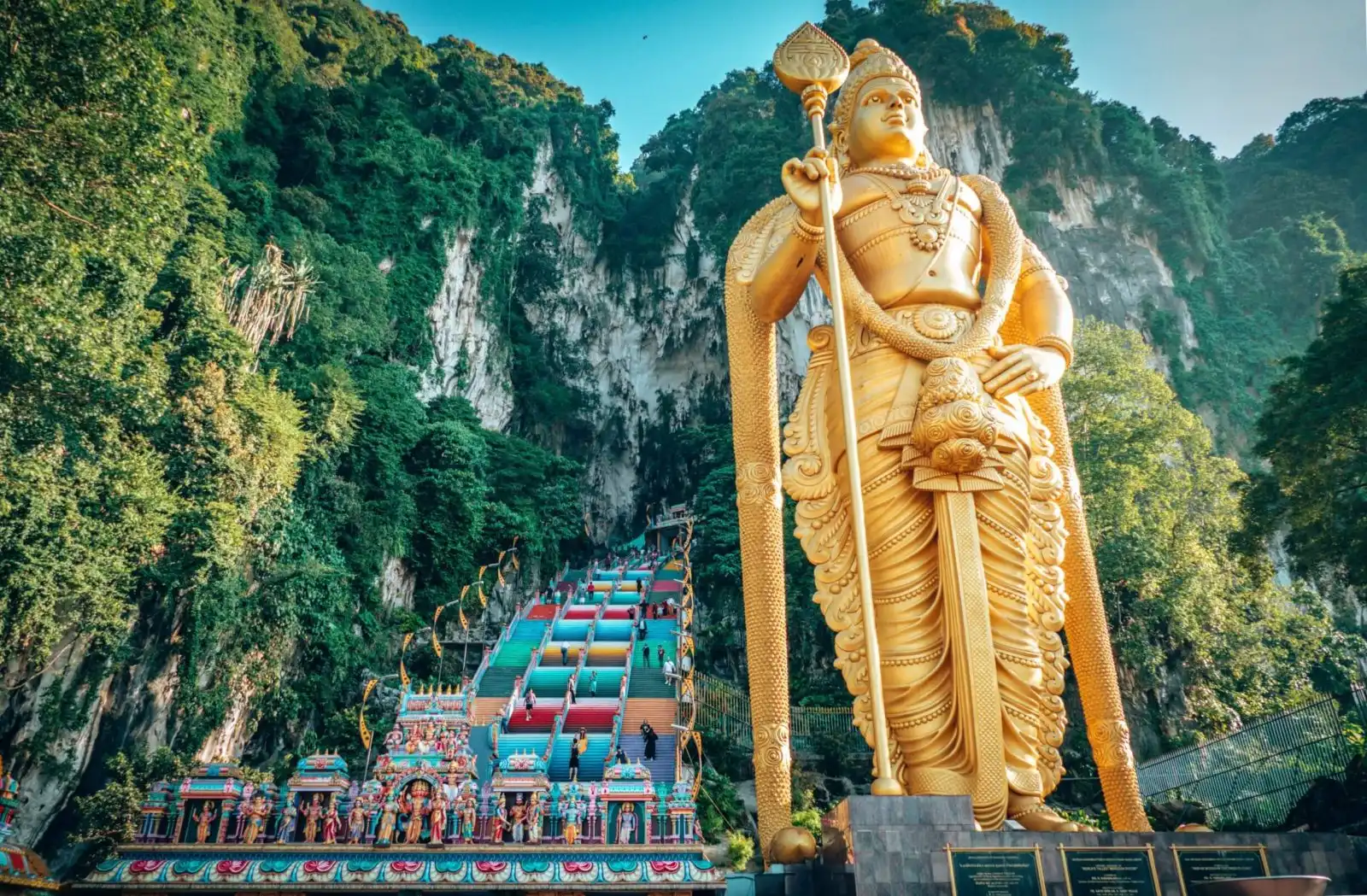
A highlight of any visit to Kuala Lumpur is a visit to the 400 million year old Batu Caves. These limestone hills housing Hindu temples and shrines play an important role in the lives of the people that call this region home and provides a glimpse into their history and culture.
A massive statue of Lord Murugan, one of the largest in the world, stands guard at the entrance. Follow in the footsteps of pilgrims to climb the numerous steps and reach a cave filled with interesting formations and religious monuments. This vantage point also offers a good view of the city below. This temple is simple but beautifully designed, surrounded by a large number of monkeys that also call this area home. Fortunately it is pretty easy to get here from the city centre and a visit to the caves is sure to be time well-spent.
The George Town Street Art, Penang
Explored by Sarah and Justin from Travel Breathe Repeat
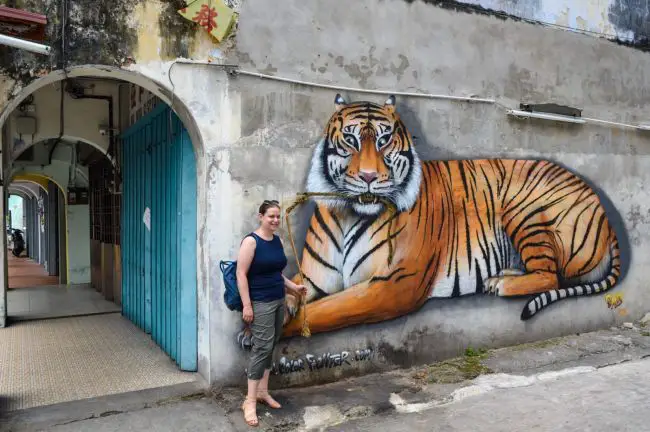
George Town is an iconic destination in Malaysia due in large part to its street art. The street art in George Town is some of the best in the world. After an epic journey from Thailand to Malaysia, we spent a few incredibly fun days in the city eating delicious food and hunting for these beautiful and interesting murals.
The street art in George Town is especially unique because so many of the pieces are interactive. You can hold a rope in the mouth of an enormous, lifelike tiger. Or sit on a motorcycle, taking the place of the boy painted on the wall.
The artwork is also interesting because they’re so well integrated into their surroundings. A penguin looks like he’s standing on a pipe as he spray paints the wall you’re looking at. Two kids hang out of a painted window next to a real door of a shop.
You can find the most famous pieces on a George Town street art map or even join a guided tour. Even if you do this, though, you should also just keep constant lookout for the cheeky paintings hiding all over the city. It’s a joy to spot the animals and children popping out of unexpected places and contributes to making George Town a truly fun place to explore.
The Pavilion Building, Kuching, Sarawak
Explored by Wendy from The Nomadic Vegan
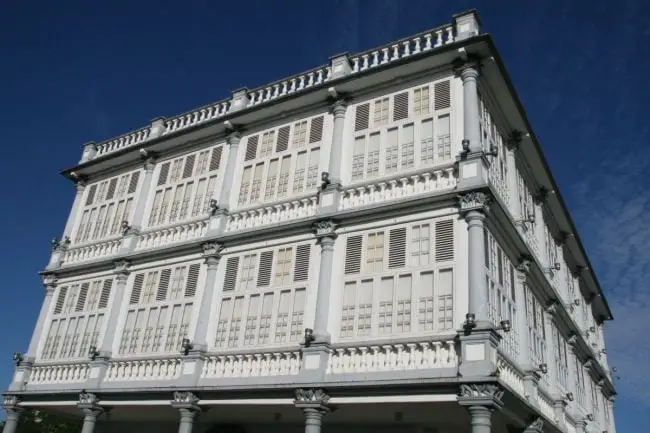
A multicultural place that is home to many different ethnicities, the far-flung state of Sarawak on the island of Borneo has a history that’s quite different from Penang and other tourist hotspots in peninsular Malaysia. Easily recognizable by its box-like shape, the Pavilion Building is an iconic landmark of Sarawak’s unique colonial history. Originally part of Brunei, what is now Sarawak was given to a British adventurer named James Brooke, who ruled it as his own personal kingdom. He and his successors are known collectively as the White Rajahs. It was during the reign of the White Rajahs that the Pavilion Building was built in 1907, originally as a hospital.
This was the first public building constructed in the city that was more than two stories tall. While it has since been surpassed by a number of skyscrapers, it remains one of the most striking landmarks in Kuching. Nowadays, it houses the Sarawak Textile Museum, which displays textiles handwoven by members of the various ethnic groups that live in Sarawak.
Kota Kinabalu City Mosque,
Explored by Arrianne from Travel Habeat
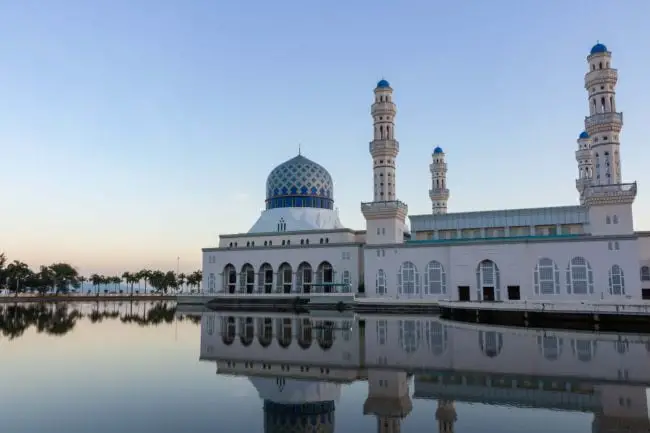
The largest one in the city of Kota Kinabalu, Kota Kinabalu City Mosque can hold 12,000 worshippers at once. Mainly white, it is decorated by a blue and gold dome. Kota Kinabalu City Mosque is simply stunning on its own, embodying a contemporary Islamic architecture. But what makes it utterly unique, is the presence of the man-made lagoon surrounding it. It is sometimes called “The Floating Mosque” because of the illusion from afar that it sits atop the still water.
But its charm doesn’t end there. Wait until the blue hour strikes and Kota Kinabalu City Mosque will take your breath away. Its beautiful reflection illuminates the water. As such, it has actually become a sought-after Malaysian landmark for photographers exploring the area. Non-Muslims can enter the mosque outside regular praying times but proper clothing must be strictly observed. Costing you a few Malaysian Ringgit, there are available robes for rent in case you need one.
Alluring as it is, Kota Kinabalu City Mosque is no doubt one of the most iconic landmarks not only in the city but in the entire country as well.
The Khoo Kongsi Clanhouse, Penang
Explored by James from Where You’re Between
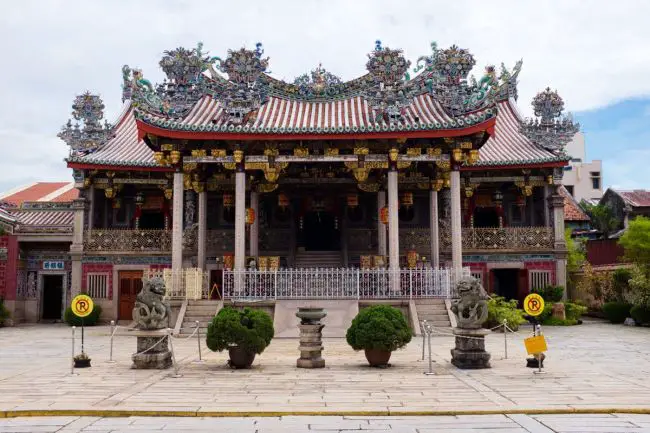
Penang’s large Chinese community has left a huge cultural mark on the city. Nowhere is this more evident than at the stunning Khoo Kongsi clanhouse, right in the heart of Penang.
Chinese communities frequently established clanhouses in various cities all over Asia to help new arrivals from the homeland settle overseas. Penang’s Khoo Kongsi clanhouse is one of many in the city and easily the most spectacular. Hidden amongst a private square, this Malaysian landmark is set away from the hustle and bustle of central Penang. And at the heart of the complex is the clanhouse’s breath-taking main hall, decorated in stunning detail.
Underneath its hugely elaborate sloping roof, the hall’s columns and veranda are adorned with incredible intricately carved stonework. Inside, altars are decorated in glistening gold leaf whilst the walls are covered in ancient murals that depict ancient tales from Chinese folklore.
Opposite the main hall is an open air theatre that is still used to host Chinese operas. Around the edge of the clanhouse’s courtyard are sixty terraced houses, built in the 1900s as homes for members of the clan. Some of these homes have since been converted to excellent accommodation and make a great place to stay right in the historic centre of Penang.
Sri Mahamariamman Temple, Kuala Lumpur
Explored by Shireen from The Happy Days Travels
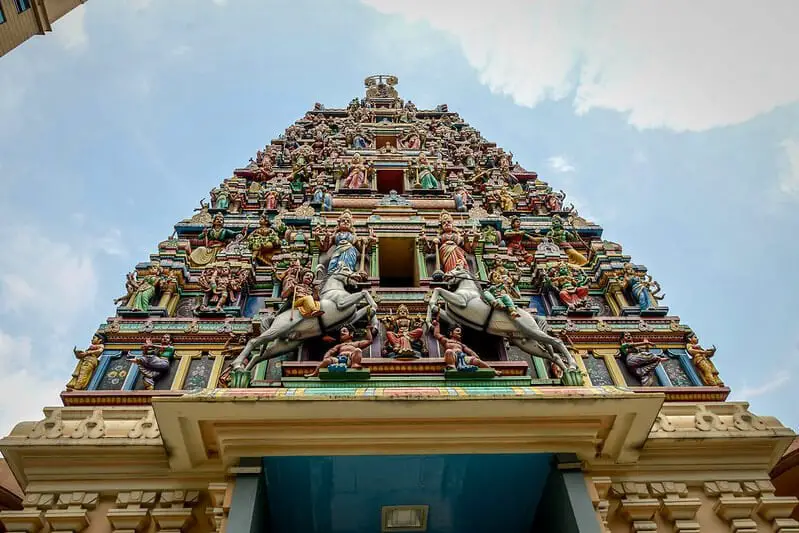
When visiting a place that has large religious communities, I find it’s important to learn about those religions and cultures, so I try to visit somewhere that provides this education. I did this frequently during my three weeks travelling Malaysia which included visiting Kuala Lumpur, Penang and Borneo.
One of the iconic religious landmarks to visit in Kuala Lumpur is the Hindu Sri Mahamariamman Temple. It is the oldest Hindu temple in Kuala Lumpur having been founded in 1873. The impressive architecture boasts a 5 tier tower, making it unmissable as you’re walking the neighbourhood. Reflecting the diversity and multiculturalism of not only KL but also the country, you’ll find other temples and a mosque in the surrounding area.
Sri Mahamariamman Temple is open to visitors (Hindus and Non-Hindus) where you can walk around admiring the intricate details of the architecture. There is usually music to be heard and ceremonies/practices to be observed. Entry to the temple is free but there is a small fee for safe storage of your shoes, like many places of worship in Southeast Asia, shoes are not allowed inside the temple.
This iconic landmark in Malaysia is special to visit because it allows you to observe practices from the Hindu religion as well as gain insight into a massive part of Kuala Lumpur’s diversity.
Old Town Street Art, Ipoh
Explored by James from The Travel Scribes
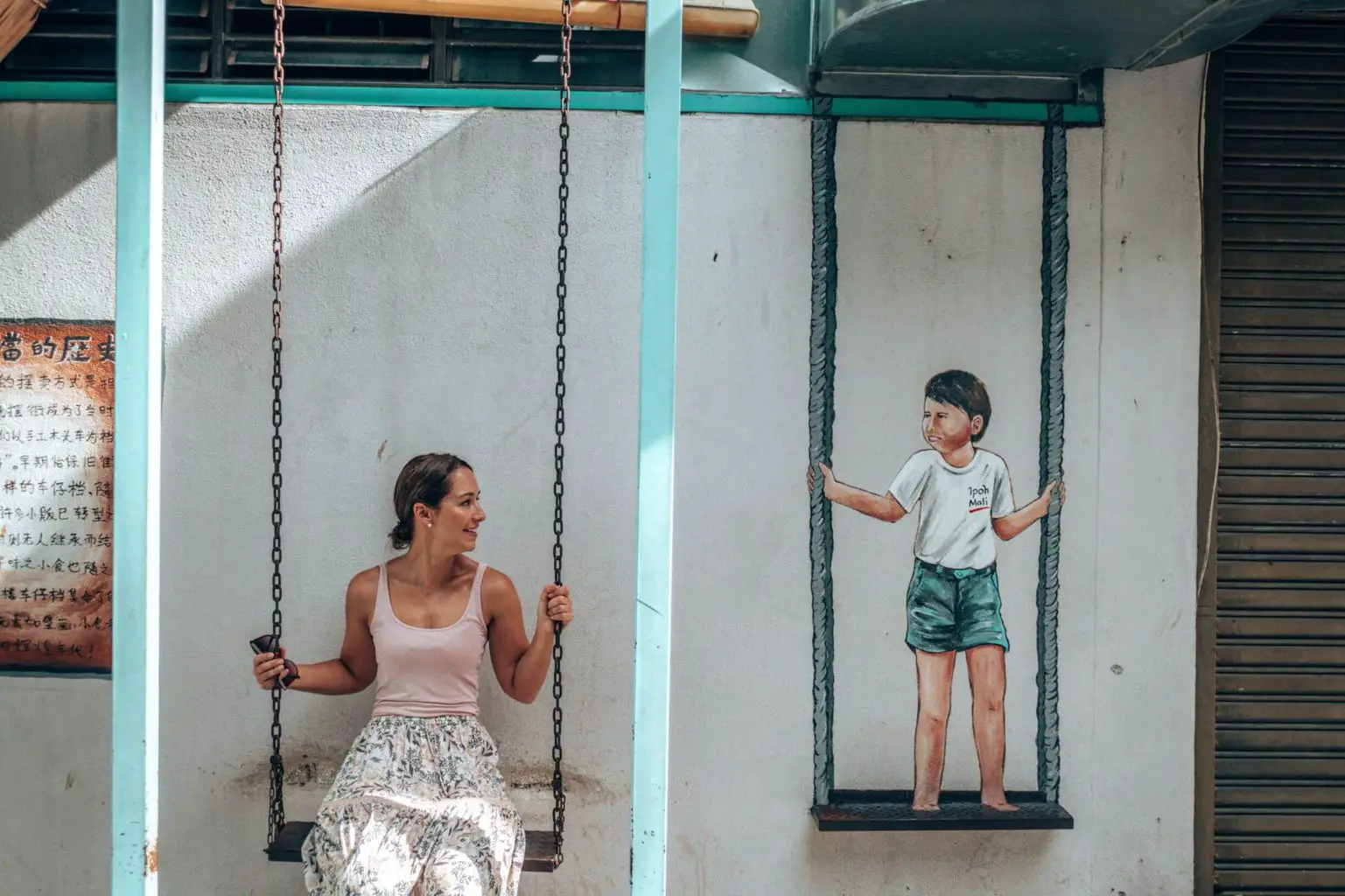
If you ask tourists and travellers about their favourite experiences in Malaysia, many will mention walking the streets and exploring the amazing street art of the country. George Town, Penang will usually be at the top of the list, but I’d like to make a punt for my beloved street art hotspot and undiscovered gem: Ipoh.
The street art in Ipoh might not be as expansive as Penang but you definitely won’t be jockeying for position among thousands of other tourists, as Ipoh is still a little off the beaten traveller trail. A town originally founded around tin mining, residents left in droves in the late 20th century, with the decline of that industry. It’s only in the last few years that tourism has brought more people back to Ipoh and alongside it’s famous ‘white coffee’ and incredible hawker food stalls, street art is one of the major drawcards.
The first pieces of art were created by prolific street artist, Ernest Zacharevic, a Lithuanian-born artist who has become known as the ‘Banksy’ of Malaysia. He travelled to Ipoh to work with Old Town White Coffee, a coffee chain, to create a set of six murals across the city and, from there, the culture of street art took hold in Ipoh. To get a true feel for the art, you simply need to walk around the old town or head to the Mural Arts Lane, an alley in the newer part of town dedicated to the art.
Jonker Street, Melaka
Explored by Yen from the Wandering Journal
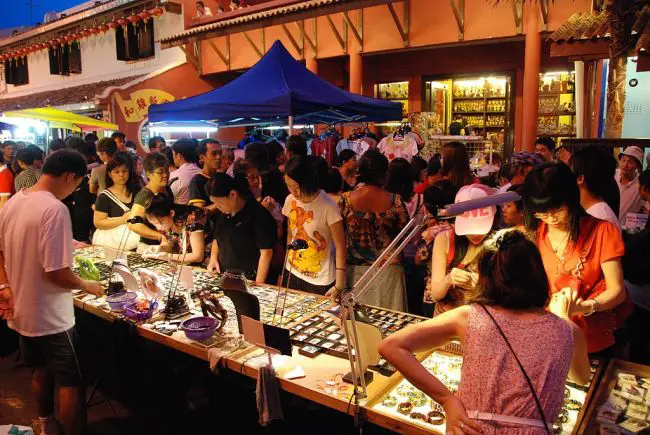
Jonker Street, (or Jalan Jonker) is probably the most visited street in Melaka, has been around for centuries, dating back to the Dutch colonial era. After the Dutch left, the Peranakans settled down in this area, leaving behind the Nyonya Baba-influenced architecture and culture as we see today.
Wandering around Jonker Street is one of the best things to do in Melaka. Moreover, the street is located perpendicular to the Melaka River which also offers a river cruise to explore the surrounding area, including the amazing Kampung Morten.
But what’s so special about Jonker Street? Well, it might look like an ordinary street in the day, with several concept stores and restaurants along the street. When the sun goes down on Friday, Saturday and Sunday, the street is quickly transformed into a vibrant night market with plenty of stalls filling up the street.
It’s easily the busiest street in Melaka at that time, attracting visitors from all around the city. Even people from Kuala Lumpur drive all the way down there for a weekend getaway trip.
To visit Jonker Street, there are a lot of accommodations all along the Melaka River, which makes your visit effortless. Backpacker hostels, luxury hotels, you can find accommodations of all ranges.
Pay a visit to the night market and enjoy the experience!
The Floating Mosque, Melaka
Explored by Rose from Where Goes Rose
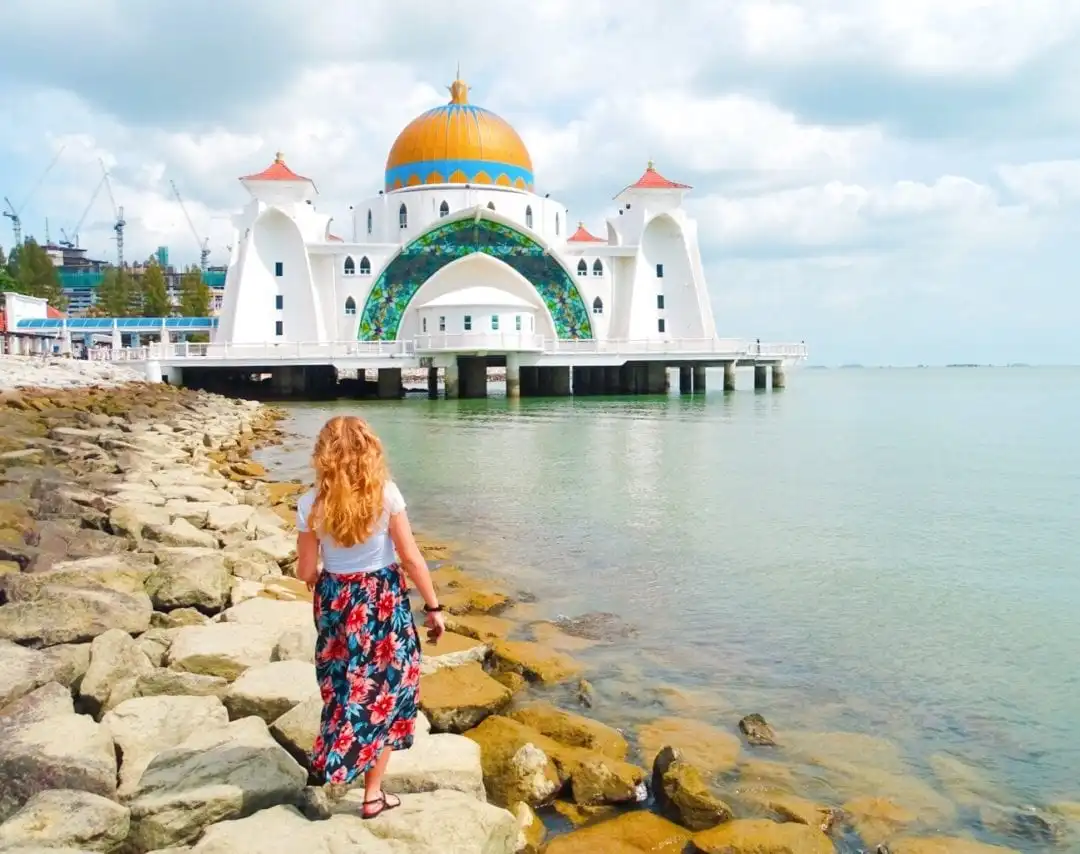
One of the most unique and impressive things to do in Melaka is visit Melaka Straits Mosque, otherwise known as the Floating Mosque. This large mosque built beside the ocean gives the impression it’s floating on the water, although it actually rests on stilts.
Unlike many of the historical buildings in sleepy Melaka, the Floating Mosque was only built in 2006. The primary religion in Malaysia is Islam, and this mosque is a great example of Islamic landmarks in Malaysia. There are also large Indian and Chinese communities who worship at their own Hindu and Taoist temples, providing the country with a rich multicultural mix.
Going inside the mosque is free but you should have your knees and shoulders covered to be respectful. Even if you don’t go inside, you should take a trip to Melaka Straits Mosque to view the impressive building from the outside. Melaka Straits Mosque is a 10-minute drive from Melaka and can easily be reached by hailing a taxi or calling a Grab (Malaysia’s version of Uber).
Cheong Fatt Tze’s Mansion, Penang
Explore by Claire from Claire’s Footsteps
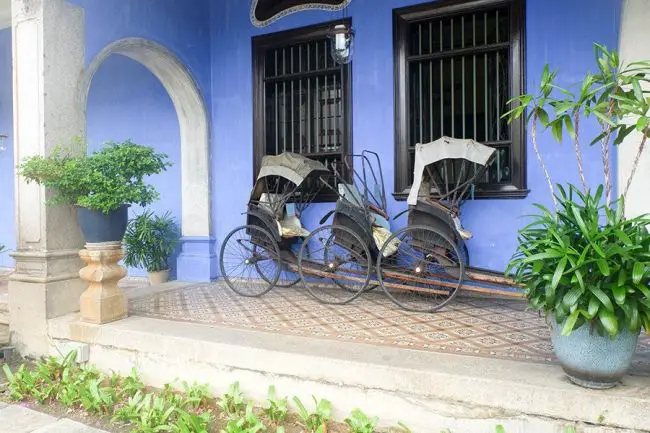
Penang is often a must-do on people’s Malaysia itinerary because of the delicious food, however it’s well worth exploring for its rich and varied history and architecture as well. Cheong Fatt Tze’s mansion, or ‘the blue mansion’ is one of the best preserved historical buildings on the island.
It was built by the wealthy self-made Chinese millionaire, Cheong Fatt Tze. He was born into a poor Chinese Hakka family and left after the Second Opium War, when the country was plunged into poverty. He moved to Indonesia, where he started lucrative rubber and tea businesses that made his fortune. Subsequently, he built this house in Penang, using Feng Shui and other Chinese interior design techniques, to create a really distinct house.
One of his best examples of this is his courtyard, which was open and would flood in rain. This was on purpose – in Chinese culture rain brings money.
It has been used for various films throughout the years, most notably Crazy Rich Asians where it is the setting for the mah jong scene.
The house is now open for guided tour only (which get excellent reviews), these tours take about 45 minutes, and suprisingly it also functions as a hotel! There is a bar, restaurant and gift shop on-site. Check at the house for tour times, as they do change.
Kuala Lumpur Forest Eco Park
Explored by Kieren from Got My Backpack
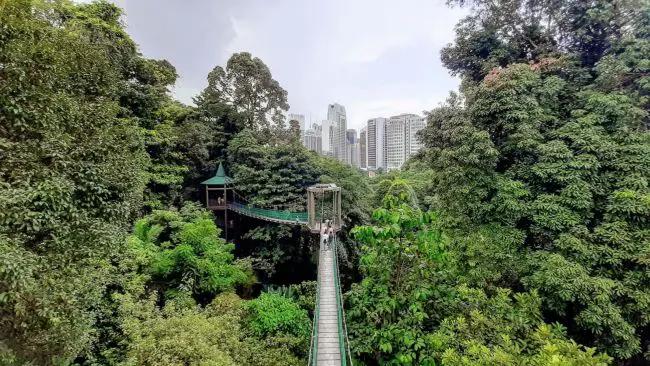
In the heart of the bustling capital of Malaysia lies a small stretch of rain forest called Kuala Lumpur Forest Eco Park. This is the last remaining section of rain forest within the city itself and holds the title of the oldest forest reserve in the country. Making it an important iconic landmark in Malaysia.
Within KL Forest Eco Park, there are a range of walking and hiking trails that are great for passing by an afternoon, one of which is a 200m canopy walk allowing for a relaxing 20 minute walk amongst the tree tops.
The combination of the nature with the backdrop of a city is a great mix and well worth a visit. If you want to get an even better birds eye view of the city, KL Tower is located right near the entrance to the par with a viewing deck taller than the Petronas Twin Towers.
As of Jan 2020, they have begun charging an entry fee which is a shame but is vital for the upkeep of this vital green space.
The Sky Bridge, Langkawi
Explored by Cal from Once in a Lifetime Journey
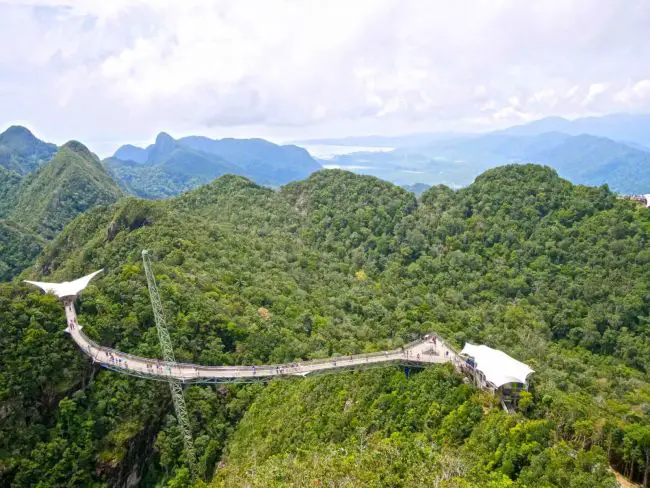
On a trip to this popular island along the west coast of Malaysia you will most likely spend most of your time on the beach, basking in the sun, cocktail in hand, in one of the most luxurious resorts in Langkawi.
Yet you’ll be missing out if you don’t go up one of its most famous landmarks, the Langkawi Sky Bridge. While walking on the 125m long curved cable bridge 660m up above the island is a must, just going up the cable car to get there is an adventure in itself. It is the world’s steepest cable car! While the queues can get intense during weekends and peak season, you’ll forget all about it as the views are breath-taking.
Once you’re at the top of the cable car, get your camera ready for some epic shots. Then either walk down the slightly steep path for around 10 minutes or take the SkyGlide cabin down to the bridge for an additional few Malaysian Ringgit. The SkyGlide takes around 2 mins. It really is amazing to see Langkawi from up above with all the gorgeous surrounding islands and azure oceans.
Lexis Hibiscus, Port Dickson
Explored by Don from The Money Saving Daddy
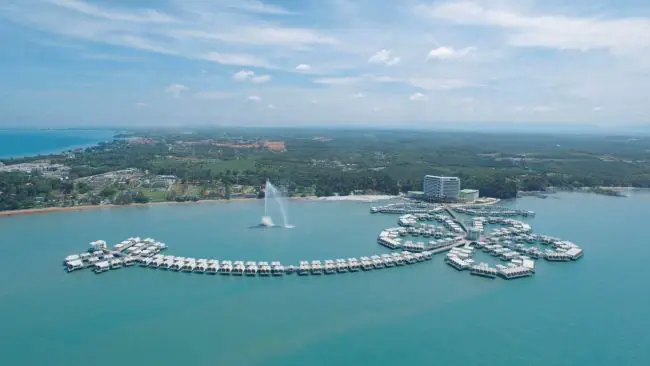
Photo Credit @ Lexis Hotel Group
You might be surprised to find a resort hotel on a list of top landmarks in Malaysia but the Lexis Hibiscus is undoubtedly an interesting design and the most unique building in Malaysia.
Just 45 minutes away from Kuala Lumpur International Airport is this fascinating resort complex which draws couples and families from around the world, all looking to stay in their private pool facilities. Why? Well the property has pool villas radiating out in the shape of a hibiscus, the national flower of Malaysia. Best seen from the air (or via a drone), its surely one of the most distinctive hotel designs in the world.
The resort definitely wanted to top not just the architectural stakes but also set a few records in the process. They hold the Guinness World Record for the most swimming pools in a resort (its 643 by the way), and the record for most overwater villas at a single resort, with 552 top-notch villas.
Next time you’re looking for a great place to stay in Malaysia, add it to your list.
Read next: Best things to do in Port Dickson.
Sultan Abdul Samad Building, Kuala Lumpur
Explored by Lee from The Travel Scribes
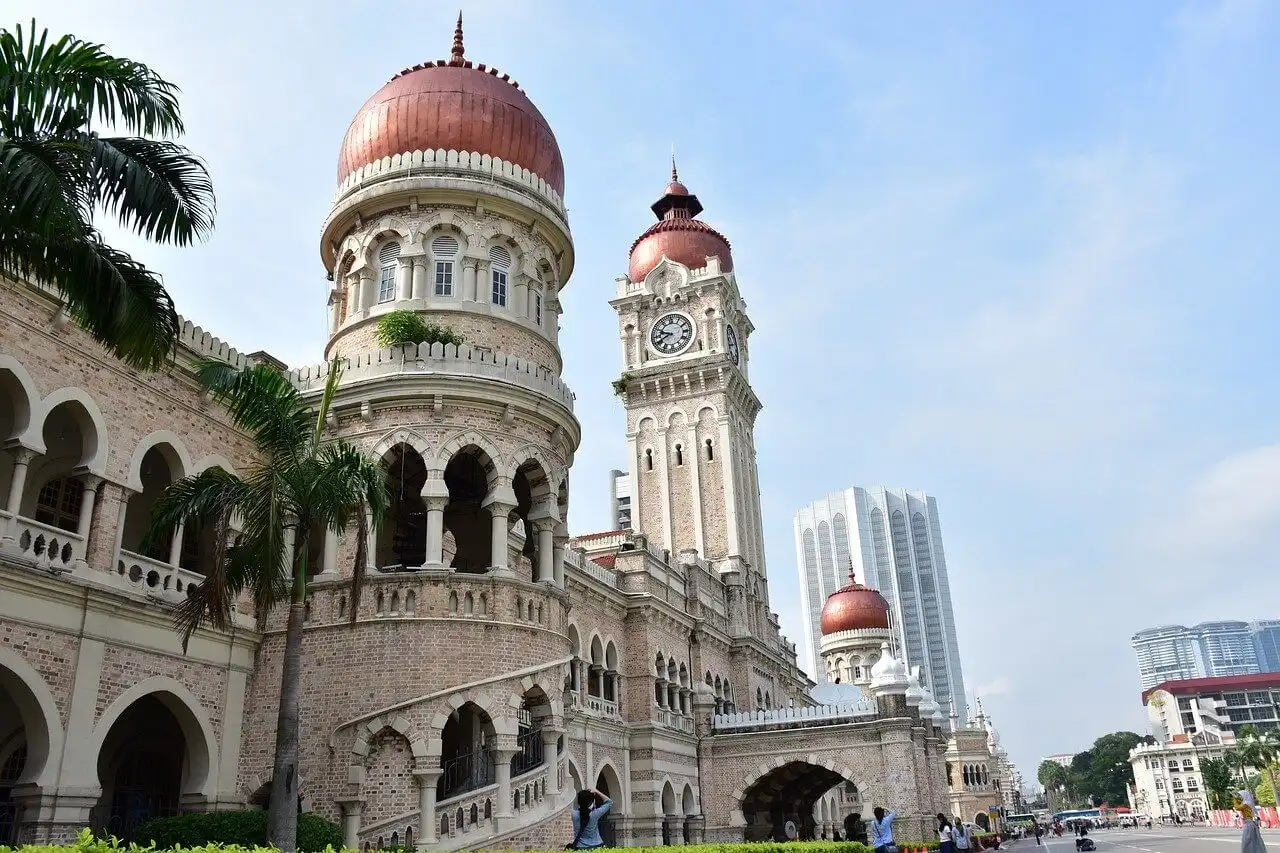
It’s a must-visit on any Kuala Lumpur itinerary, the Sultan Abdul Samad Building is part of the city’s ‘Colonial Core’, a set of older colonial buildings that provide an interesting contrast to the many high rises and skyscrapers that now dominate the city centre.
Built between 1894 and 1897, this beautiful Malaysian landmark used to be the home of many key government departments during the British rule of the country. It was originally planned to be built in a Classical Renaissance style but the State Engineer at the time, Charles Spooner, didn’t like the style and reworked it to be almost Moorish in approach.
Nowadays the Sultan Abdul Samad Building houses the country’s Ministry of Information, Communications and Culture but, more than this, provides the backdrop to the annual independence celebrations as Malaysians converge on Merdeka Square (Dataran Merdeka) in front of it each year for their Independence Day parades.
Related: Here is the ultimate Singapore and Malaysia itinerary.
Kota Kinabalu National Park
Explored by Penny from GlobeTrove
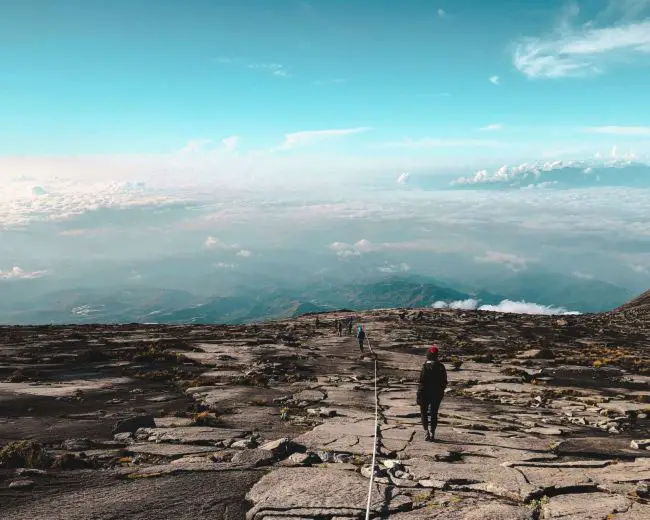
Borneo is famous for a number of landmarks but if you are a fan of the great outdoors then Kota Kinabalu park is probably calling your name.
The park is centered around Mount Kota Kinabalu which is the tallest peak on the island and one that people come from far and wide to tackle. The summit however is more than a day’s climb and you need to register as only a limited amount of people are allowed to trek up per day. If you aren’t a big fan of long hikes, then don’t ditch the park off your list just yet. There are numerous small trails that are perfect for a quiet peaceful walk. The forests of Borneo are diverse and interesting, so I highly recommend the visit.
The closest city is Kota Kinabalu and it is easy to get to as there are numerous flights that land here. While a lot of people love the islands that dot the coast around the city, the national park remains one of the top things to do in Kota Kinabalu. It was the highlight of our trip!
Kek Lok Si, Penang
Explored by Caroline from CK Travels
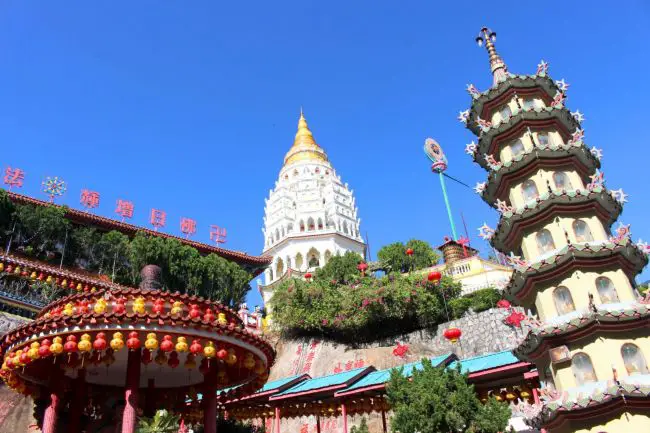
Kek Lok Si is a stunning and enormous temple situated on a hilltop at Air Itam on the island of Penang (off the west coast of Malaysia). It is the country’s largest Buddhist temple and every year thousands of people from across South East Asia visit Penang to worship at this landmark.
The temple construction was completed 115 years ago in 1905 and comprises of a series of monasteries, prayer halls, a tortoise pond, gift shops and beautifully landscaped gardens. One of the temple highlights is the impressive seven-storey Pagoda of Rama VI which holds 10,000 bronze and alabaster Buddha statues and has a mix of Chinese, Thai and Burmese architecture.
At the very top of the temple complex you will find a 30.2m high bronze statue of Kuan Yin (the Goddess of Mercy) and amazing views across the island.
The best time to visit Kek Lok Si temple is during the Chinese New Year celebrations, when the temple is illuminated with thousands of LED lights, and adorned with many colourful hanging lanterns.
Kek Lok Si opening hours are from 8.30am–5:30pm daily and admission is free, (except for a small charge of 3 MYR for the elevator and 2 MYR for pagoda entrance).
Darul Hana Bridge and Sarawak State Assembly Building, Sarawak
Explored by Fiona from Passport and Piano
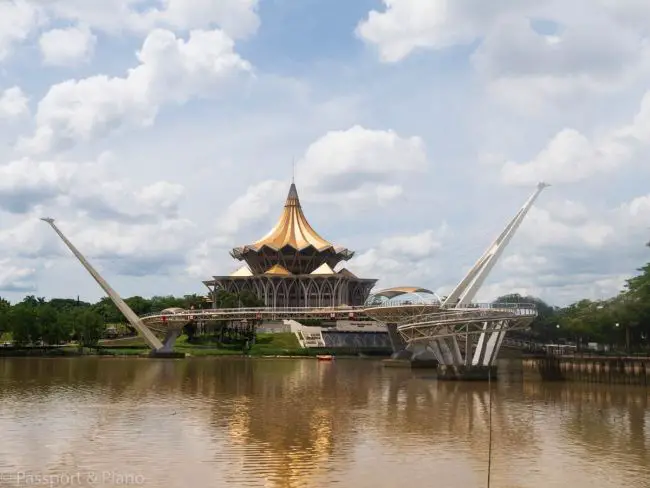
Kuching makes a great place to stay if you are visiting Borneo in Malaysia and it’s from here that you can fly to the famous Mulu Caves. From the town, you can easily take day trips to see the orangutans and visit Bako National Park, which is one of the best places to see proboscis monkeys.
Around town, there’s lots of great restaurants and some fantastic street art. At night most people head to the riverfront to watch the daily light show from the iconic Darul Hana bridge. The bridge is spectacular and looks beautiful when it’s all lit up in bright colours at night. The bridge links the northern and southern parts of the city together. It’s built in the shape of an “S” for Sarawak and the views across the river and spectacular.
If you walk across the bridge, you can walk along the esplanade to both the Fort Margherita and the Sarawak State building. Both are magnificent landmarks, but the golden roof of the state building is the one that will catch your eye.
To get the best views of the bridge, the Sarawak State building and the fort opt for a river ride in one of the traditional boats. You’ll also pass the mosque, which is another beautiful building.
Jamek Mosque, Kuala Lumpur
Explored by Delilah from Our Travel Mix
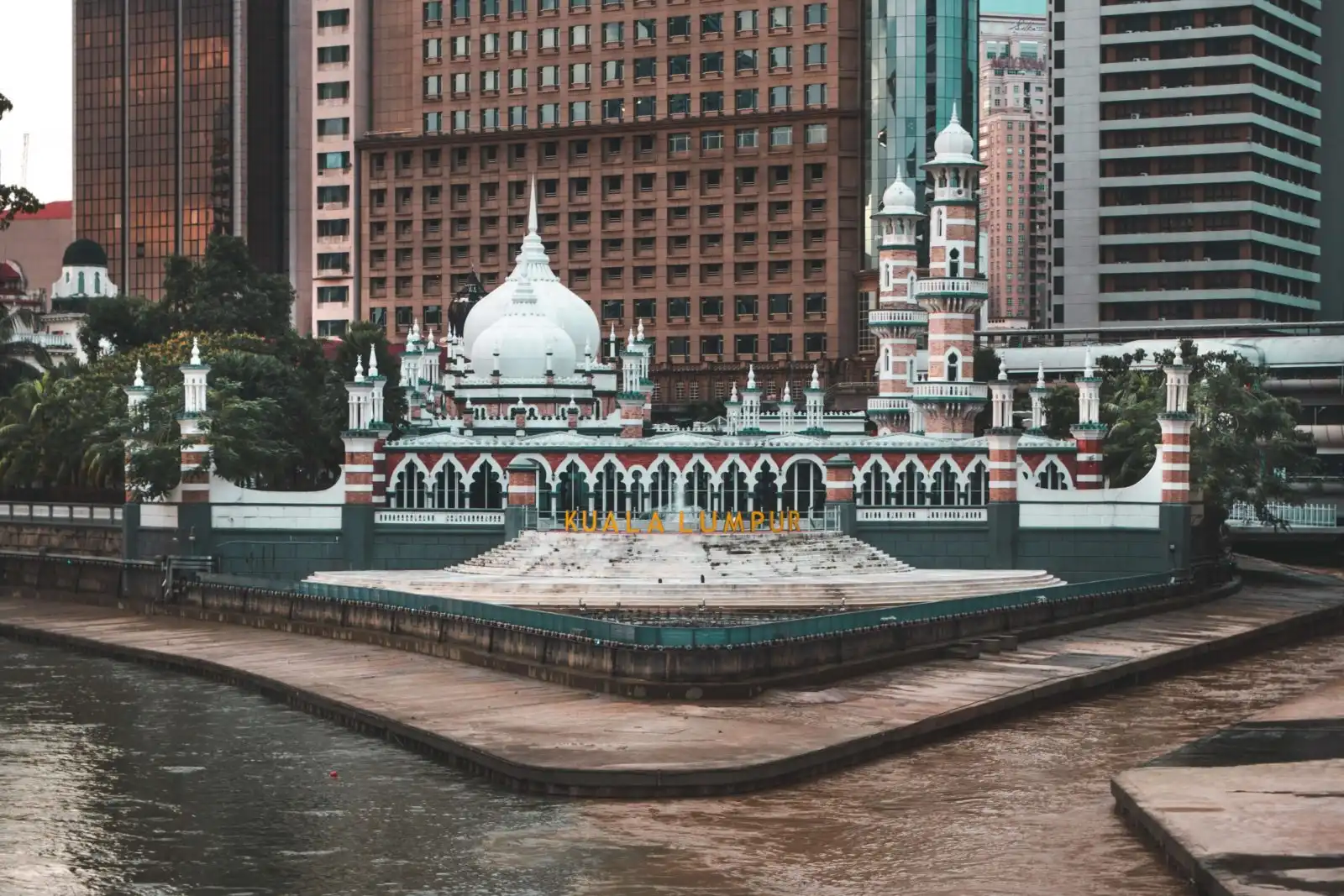
Masjid Jamek (Jamek Mosque) is the oldest mosque in Kuala Lumpur, having been built in 1909. It’s Moorish architecture features stunning patterns on the facade of the building, patterned archways and large white domes.
You can visit this attraction during set hours, from 10am to 12.30pm and 2.30pm to 4pm daily, except Friday. This is to provide times for prayer without tourists. Being in the heart of Kuala Lumpur city, it’s easy to get to Masjid Jamek by public transport.
Masjid Jamek is an especially welcoming mosque, offering free entry for tourists, including personal guided tours around the complex. Many mosques allow tourists to visit, however, with a guided tour you will get to learn so much more about the Islam religion. The guides speak excellent English and are very enthusiastic.
It is also important to note that, as with all mosques, it is respectful to wear clothing that covers your shoulders and knees. If you aren’t dressed appropriately, you can borrow a robe for free.
This is one of the most iconic landmarks to visit in Kuala Lumpur and one of our favourite mosques.
Cameron Highlands Tea Fields, Pahang
Explored by Emily from Wander-Lush
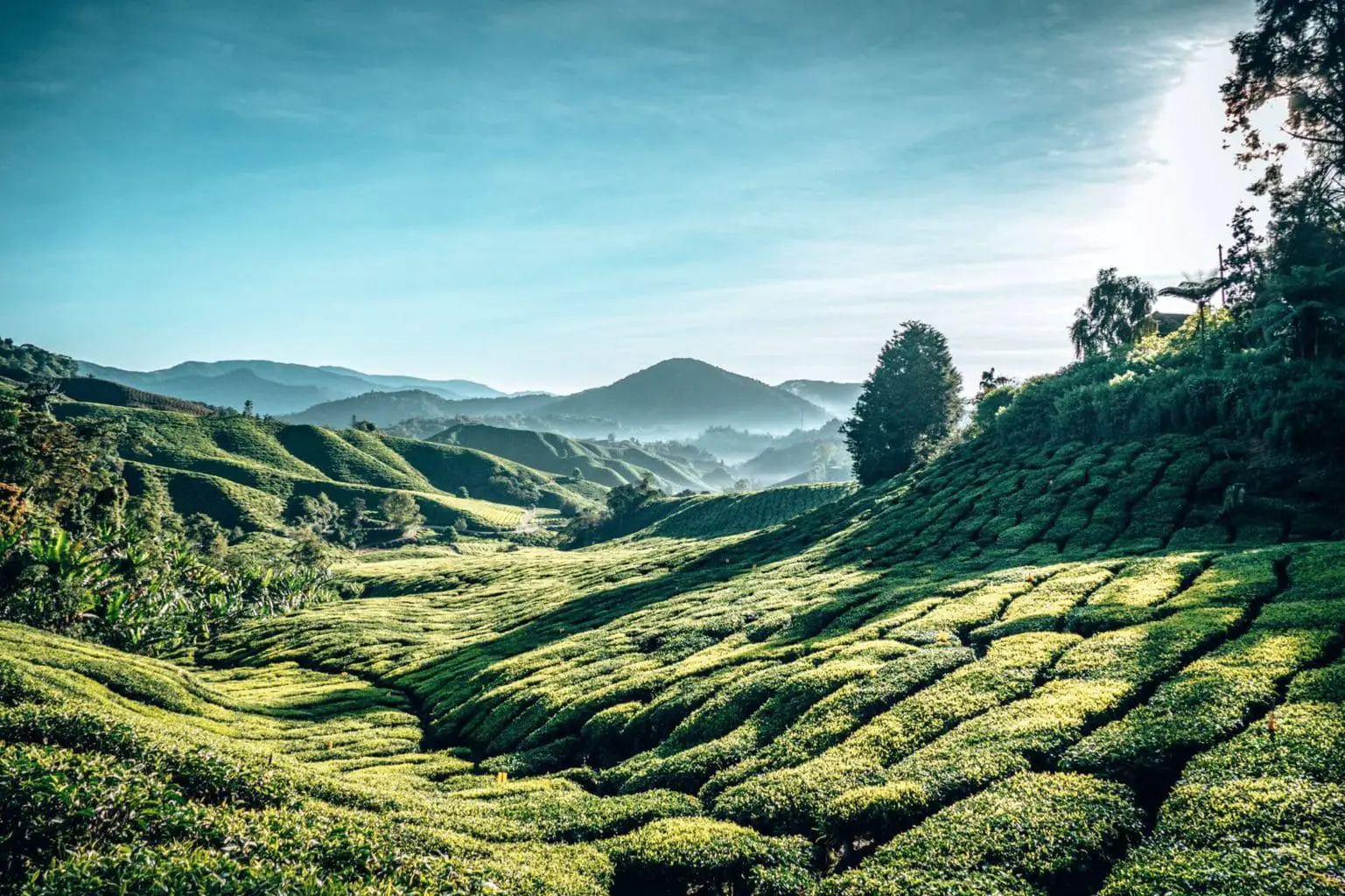
When it comes to iconic landmarks in Malaysia, it doesn’t get much better than the verdant tea fields of the Cameron Highlands district. What makes this area so special is that it captures the many layers of Malaysia’s charm: Natural beauty, colonial heritage, local produce.
Located in Pahang in the central part of peninsular Malaysia, the area is a natural plateau bounded by the Titiwangsa Mountains. The microclimate makes it the perfect place for raising tea and other crops, and in the 1930s, the area was developed by Malaysia’s ruling British government for exactly this purpose.
Today, Cameron Highlands is known for its tea estates, flower nurseries, strawberry farms and fruit orchards – all of which are a tourist magnet. The most iconic image of the Cameron Highlands is an undulating blanket of tea bushels that stretches out to the horizon against a backdrop of mountains. The best place to go for a view is Boh plantation, which has the largest slice of land – a massive 3,200 hectares of plants and processing facilities. There’s also a tea room on-site that serves up a rather lovely cuppa.
Cameron Highlands can be visited from Kuala Lumpur or nearby Ipoh. You can see a lot of the area in a day, but I recommend staying a few nights to visit some of the smaller plantations and go trekking in the nearby rainforest. The most convenient place to base yourself is in the town of Tanah Rata, where you’ll find a good range of accommodations and restaurants. If you can, try to avoid visiting on weekends and public holidays when the area is crowded with day trippers from KL.
Christ Church, Melaka
Explored by Bridget from the Flash Packer
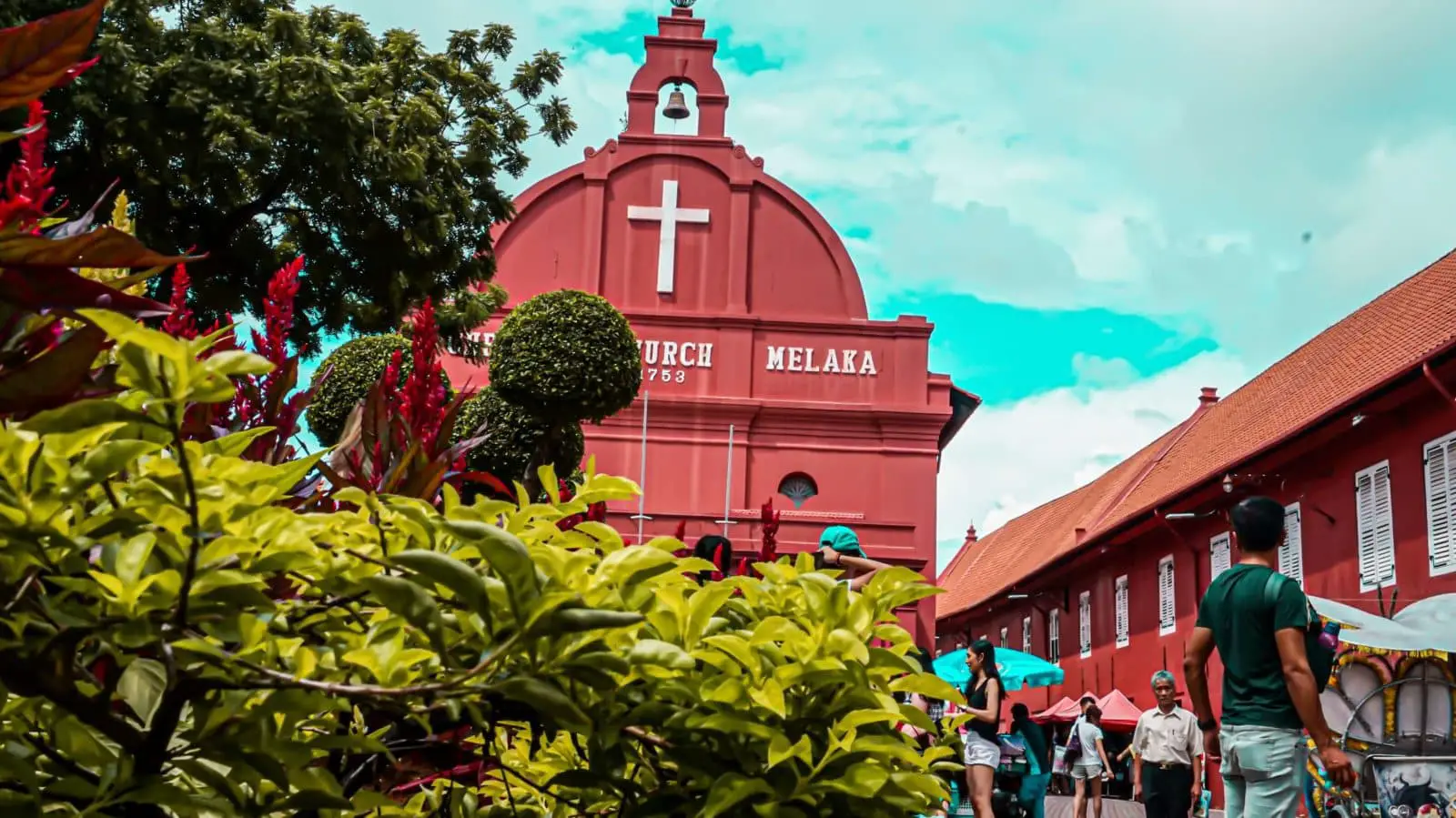
The UNESCO World Heritagecity of Melaka bears testament to its rich history. From its humble beginnings as a fishing village founded by a Sumatran Hindu prince in the 14th Century, it was colonised by the Portuguese, the Dutch and the British before gaining independence in 1946.
We have the Dutch to thank for Melaka’s iconic landmark, Christ Church, one of the most photographed sites in the city and a must-see building in Malaysia. This distinctive 18thCentury church is built from pink-red laterite bricks shipped from Zeeland and its floor is studded with Dutch and Armenian tombstones. Christ Church’s original pews remain, as do its massive 15-meter ceiling beams, each hewn from a single tree trunk.
Christ Church is located on the town square by the riverfront, opposite Melaka’s imposing Stadthuys. It is open from 8.30am – 5pm and entry is free (but donation encouraged).
A heads-up that Melaka can be ridiculously busy, particularly at weekends. To avoid the worst of the crowds wielding their selfie-sticks, visit early in the day.
Taman Negara National Park
Explored by Elisa from World in Paris
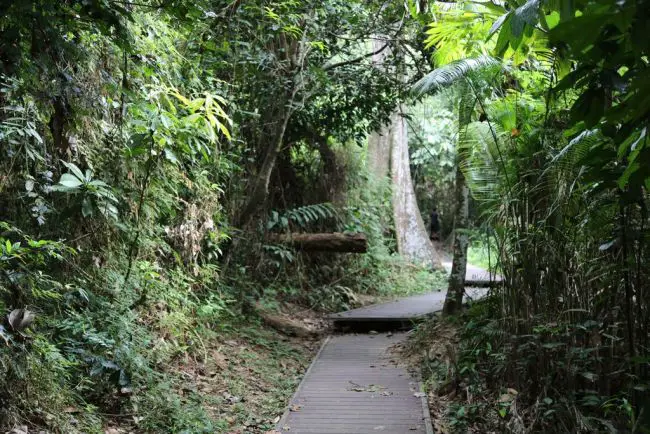
Taman Negara National Park is a very special place in Malaysia. This is the most primitive virgin rainforest in the world, much older than the Amazonian forest! Scientists estimate that Taman Negara has more than 130 million years so if you love nature you cannot miss Taman Negara while you are visiting Malaysia.
This incredible rainforest is located 3 hour drive from Kuala Lumpur, the capital. Public transportation is scarce so we recommend arranging transportation with your accommodation in Taman Negara. We stayed in Mutian Taman Negara Resort, located in the heart of the jungle, and they propose a daily shared van for an additional fee.
People visit Taman Negara for its outdoor activities. There are riverboat trips and many trails to enjoy the trees and plants of this incredible forest, being the canopy walkway the most popular one. Lucky hikers will be able to spot exotic animals and perhaps the largest flower of the world – the Rafflesia flower. The Rafflesia flower is rare, it takes six to nine months to bloom but only lasts three to four days and apparently it smells very bad!
Thean Hou Temple, Kuala Lumpur
Explored by Lee from The Travel Scribes
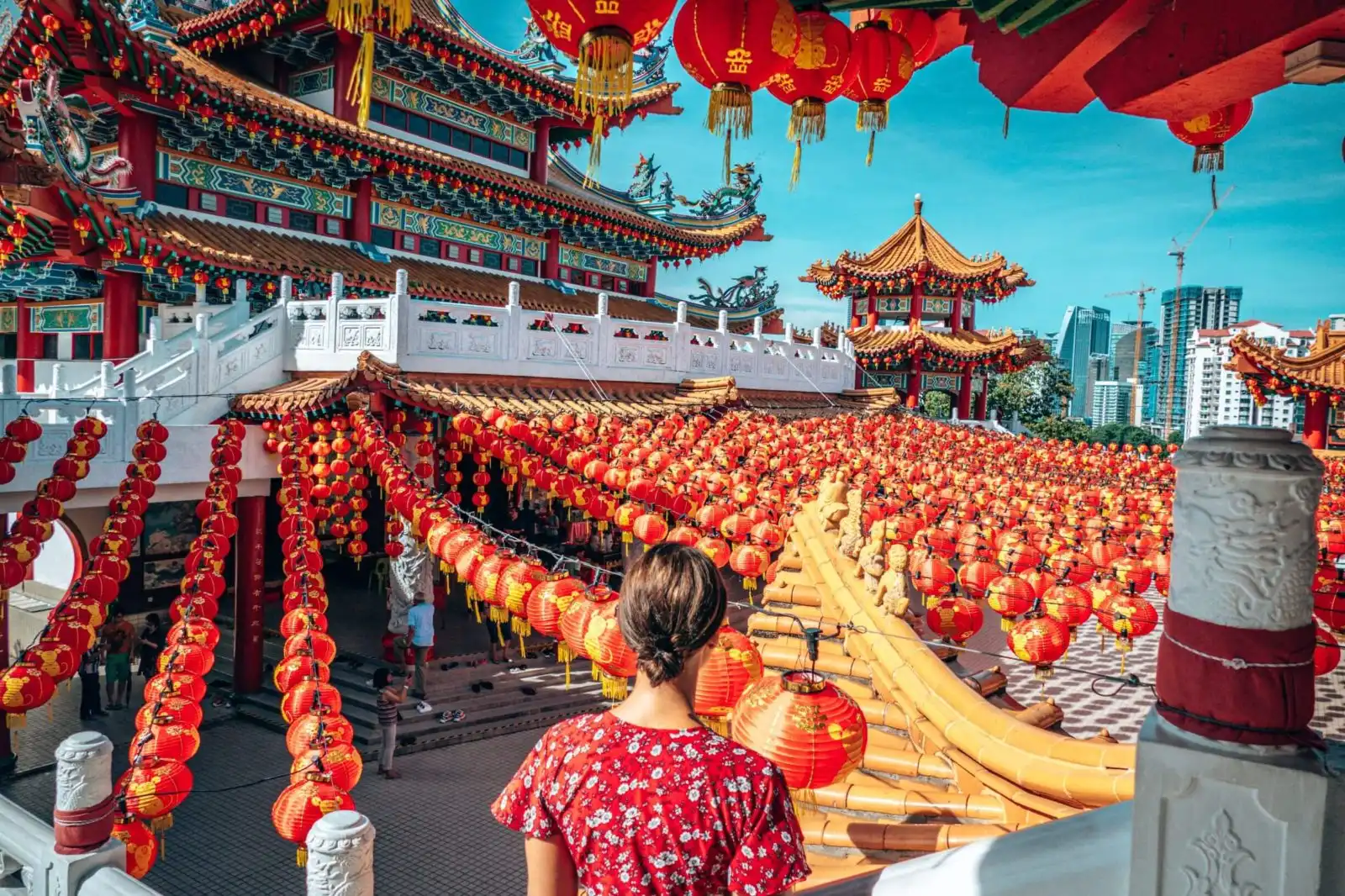
It’s one of the largest and most impressive Chinese temples in all of South East Asia, and we’d probably count it as one of the most ‘photogenic’ we’ve ever seen. The Thean Hou Temple, located just shy of the centre of Kuala Lumpur, is a magnificent example of Taoist, Confucianist and Buddhist culture and architecture that you must visit if checking out the Malaysian capital.
It’s not actually that old, only being built in 1987 and opened in 1989, but it’s a marvel of a building – six spectacular tiers all dedicated to the Chinese sea goddess, Mazu. You’ll find an incredibly ornate roof, intricate pillars and carvings and every corner of this temple offers you a stunning view back over Kuala Lumpur, as it is conveniently situated high up on Robson Hill. Mostly decked out in accents of bright red, the colour that symbolises prosperity and good fortune, you’ll often find beautiful lanterns strung up across the temple; particularly around Chinese New Year when the temple really comes to life.
As with most attractions in Malaysia, we’d recommend arriving early before the tour groups, although the temple only opens at 9.00am.
What do you think of our iconic places and famous landmarks in Malaysia list? Let us know in the comments below if there are any Malaysia landmarks that are missing!
Or if you are interested in other landmarks in Asia, check out some of the amazing building and iconic places that made it onto our lists:
- 21 Iconic building and landmarks in Singapore
- Famous places in Myanmar
- Most iconic buildings and landmarks in Vietnam
- The most iconic landmarks in Sri Lanka
- The ultimate Indonesia landmarks
- Thailand’s 21 most iconic places
- Top 10 landmarks to visit in China.
Want to save this for later? Why not pin it…
